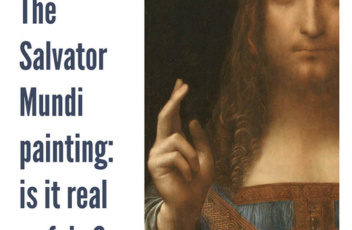The authenticity of Salvator Mundi is a matter of ongoing debate among art historians. Some experts believe that it is a genuine work by Leonardo da Vinci, while others believe that it is a copy or a workshop painting. There is evidence to support both sides of the argument. The painting’s style is consistent with Leonardo’s other works, and it has been authenticated by some of the world’s leading experts on da Vinci. However, there are also some inconsistencies in the painting’s execution, composition and some experts believe that it may have been significantly altered over time.
In 2017, Salvator Mundi was sold for a record-breaking $450 million at Christie’s auction house. The buyer was a Saudi Arabian prince, who later donated the painting to the Louvre Abu Dhabi. However, in 2019, the Louvre Abu Dhabi announced that it would not be displaying the painting, citing “technical and logistical challenges.”
After reviewing the available information online, images and other literature I’ve found about this painting, I believe that the Salvator Mundi is not painted by Leonardo da Vinci. If not a skillful forgery, this painting may have the underpainting done by Leonardo with the rest got filled in by one of his students at best. The more I study this painting, the more inconsistencies I see in the Salvator Mundi.
In the following article you’ll find why the authentication process of da Vinci’s work is so speculative.
The Salvator Mundi oil painting by Leonardo da Vinci (Italian, 1452-1519): is it real or fake?
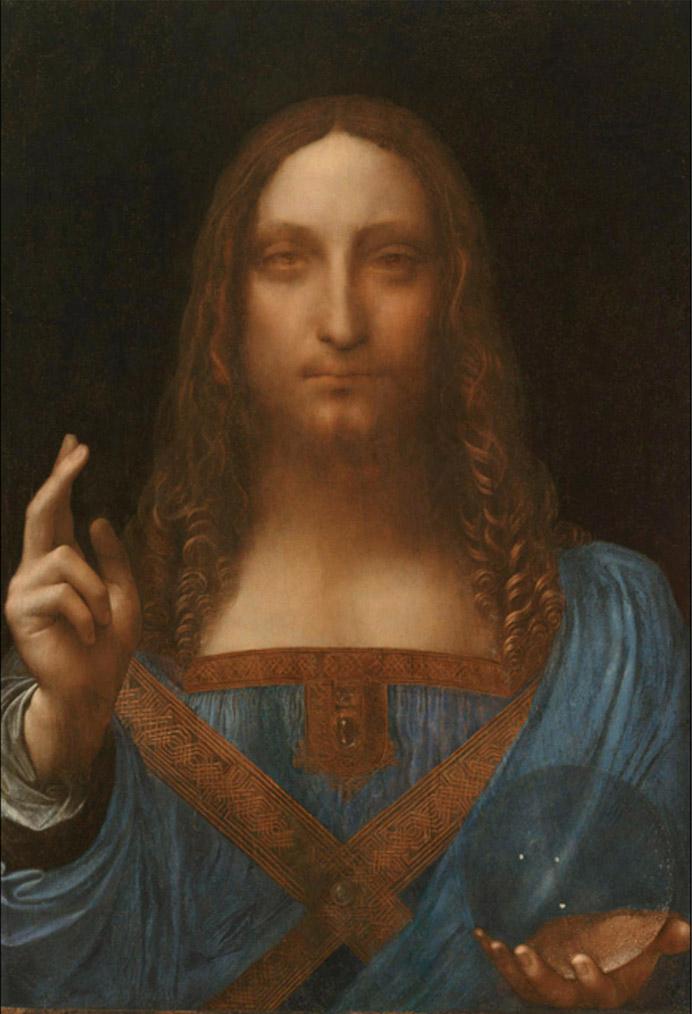
The last artwork authenticated as Leonardo’s is the Benois Madonna located at the Hermitage, St. Petersburg. It was over 100 years ago. With just about 15 paintings attributed to the artist, finding a new da Vinci is extremely rare. This is the most expensive work of art ever sold at auction. Salvator Mundi or Savior of the World sold for the astronomical $450,312,500 (that includes buyer’s premium) at Christie’s New York. While you can find plenty of information online about the artwork’s ownership and how the Salvator Mundi arrived at Christie’s, I’d like to talk about this painting from the artistic point of view and what inconsistencies I see in it as an artist. While I’m not an expert on Leonardo’s art, I’m a realist painter who designs and paints classically-inspired art.
When art sells for millions we need to question its origin. When I listened to the interview with an art dealer Robert Simon I felt for the painting and believed it was real. Simon outlined a very slow process of discoveries made about the painting. After listening to the podcast, I got interested in researching the available documentation and imagery. The more I looked, the more doubtful I became of its original creation. Here is why.
Suggested Donation podcast: http://www.suggesteddonationpodcast.com/blog/2015/9/15/episode-21-robert-simon).
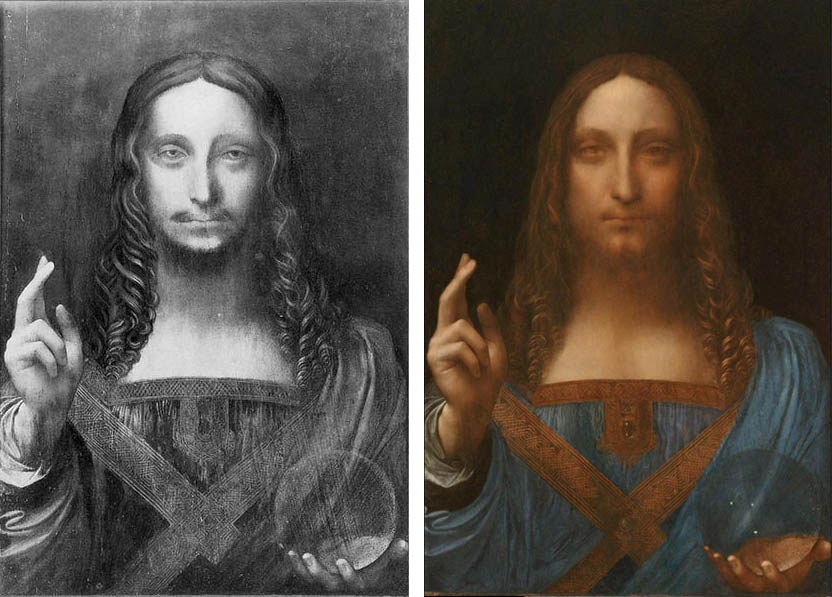
In his story Robert Simon describes the terrible condition he found the artwork in. Although he saw the beautiful hand that didn’t correspond to a harshly overpainted face stylistically, Mr. Simon had no idea it would be da Vinci at first sight. In the interview you’ll learn how slow the process of discovery was, working closely with the restorer Dianne Dwyer Modestini, Senior Research Fellow and Conservator of the Kress Program in Paintings Conservation at the Conservation Center of the Institute of Fine Arts, New York University. Both of them found clues that this painting could be by Leonardo. Eventually Robert Simon introduced this painting to the Leonardo’s experts in London to confirm the authenticity of the art.
References that suggested the existence of da Vinci’s the Salvator Mundi
In the scholarly article written by Joanne Snow-Smith she traces the whereabouts of the artist. Looking at the trail of paperwork registered in royal courts, she concludes that Louis XII, the king of France, ordered a direct commission to Leonardo da Vinci in 1507, made payments for it between 1507-11, and demanded its completion and turn over in 1513. So the original artwork was painted between 1507-1513. (Painting it on and off for many years is consistent with the artist’ habits). In 1513 da Vinci turned it in to the king’s intermediaries. Next year the king’s wife died and he donated the artwork to a convent in 1514 where it remained for over a century until it got to the Charles I royal collection.
Below you’ll find images with dates that don’t quite correspond to this timeline. For instance, Leonardo’s studies of clothed arms and chest were done between 1504-8 and many paintings with similar composition are dated before 1507. Joanne Snow-Smith proposes that Leonardo painted two copies of the Salvator Mundi based on similarities and differences in the etching, copy paintings and the Windsor castle drawings. ( Source: “The Salvator Mundi of Leonardo da Vinci” by Joanne Snow-Smith, Arte Lombarda Nuova Serie, No. 50 (1978), pp. 69-81).
So the Leonardo’s Salvator Mundi painting existed for sure, maybe even in two versions, which is also possible because the artist painted two versions of the Virgin of the Rocks. What raises questions if the etching was done from the original da Vinci’ painting hidden in the convent for a century. The etching by Hollar becomes important because it’s one of the strongest visual references to the proposed original, or perhaps, it served as a prototype for a beautiful forgery. Let me explain.
#1 reference: etching
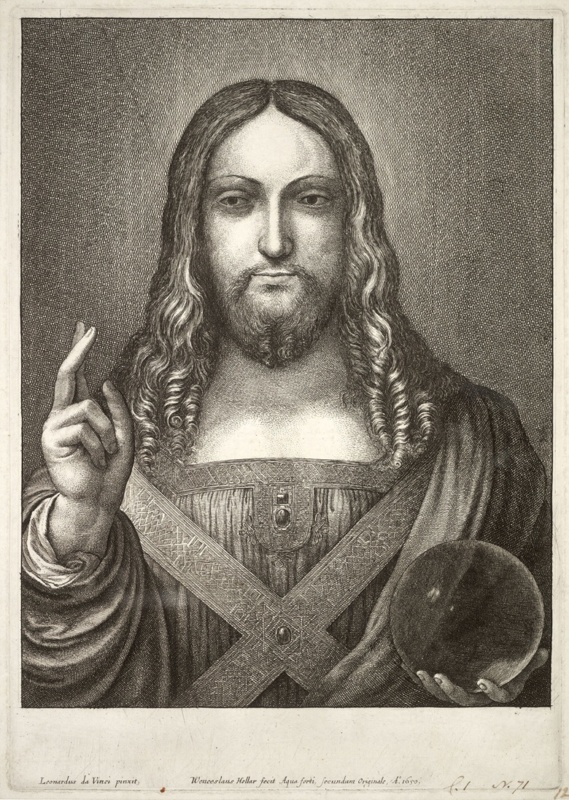
What is etching? Intaglio or etching is one of the oldest forms of printmaking where an artist would draw an image with a needle on a metal plate, engrave it with an acid, then charge it with ink to impress the picture on paper with the press. A single image could have many stages or states in its development when the artist increases contrast by building up strokes in the shadows. Every new state goes through the same process of acid corrosion, inking and printing. Because the artist hand-inks the plate and decides how much ink to remove from it, the final image may appear much lighter or darker. Not a single stroke can be removed, so artists exercised great control over the quality and quantity of their strokes. Master etchers among the old masters are Rembrandt and Durer. This printmaking process is taught in art colleges and I made a number of prints using this technique.
If we begin to compare this etching to the discovered Salvator Mundi we can observe three things. The eyes look in different direction. Christ has a definite beard in the Hollar’s etching unlike in the presented painting. The orb’s reflection is not what the scientist artist (da Vinci) would actually see but it’s similar in the etching, the da Vinci’s painting, and some copy paintings. If the etching was done from the original da Vinci, it raises questions how the artist could have ignored the effects of optics he studied so carefully. (Below you’ll find my photos of the orb and how it appears placed in a hand).
#2 reference: da Vinci’s sketches
The second strongest visual reference to the existence of the Salvator Mundi are the da Vinci’s studies located in the Windsor castle collection.
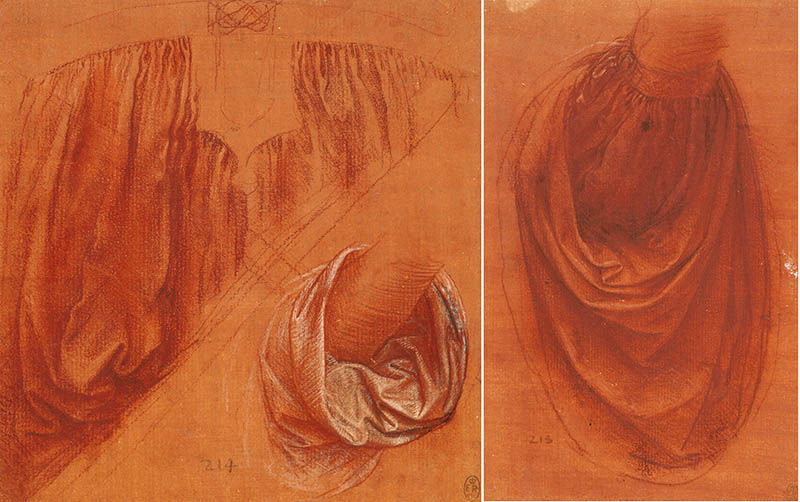
Two drapery studies – preparatory drawings for the Salvator Mundi by da Vanci – are in the royal collections at Windsor Castle, England, 1504-1508. These two drawings is a clear evidence that Leonardo studied the folds and disposition of Christ’s tunic and its sleeves. The drawings are modeled in two colors in chalk characteristic for the classical method of drawing in that period. These studies of drapery show that Leonardo was influenced by the Greco-Roman art and must have studied classical sculpture during his travels in Rome and wanted the clothing look natural and graceful. It also proves that he worked on the concept of his future painting.
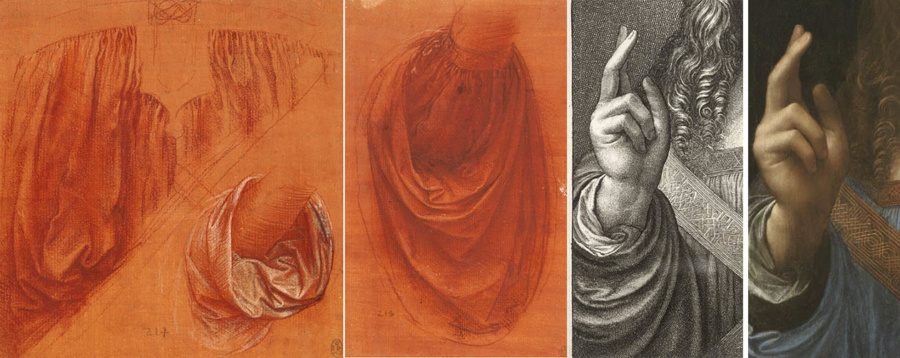
(Images: https://www.royalcollection.org.uk/collection/912525/studies-of-drapery-for-a-salvator-mundi | https://www.royalcollection.org.uk/collection/912524/a-study-of-drapery-for-a-salvator-mundi).
#3 reference: artist copies
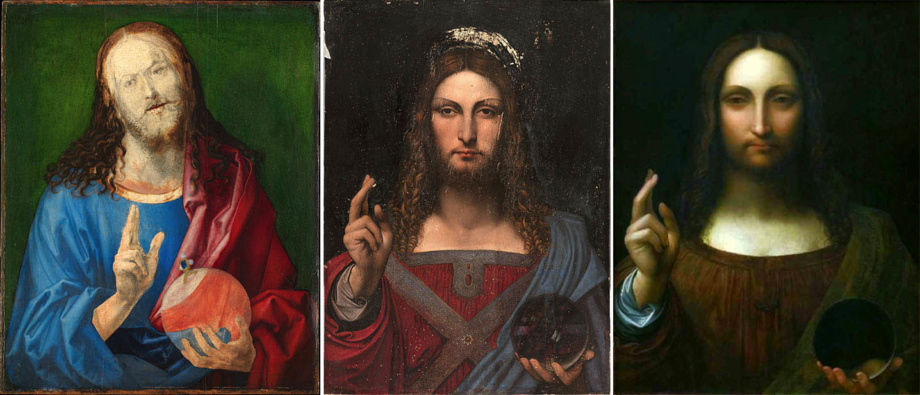
There are many copy paintings made from either the original or the etching, letting us believe that the artists were familiar with the original composition of the Salvator Mundi and painted either copies or their interpretations on the theme. By looking at these painted copies we can see striking similarities to the etching and the da Vinci’s Salvator Mundi in the depiction of both hands, the orb, and the figure positioning painted by various artists.
However, based on the existing documents and style, the da Vinci painting was painted between 1507 and 1513, while he was in the service of king Louis XII, which places some of the copies before da Vinci finished working on his painting. Unless da Vinci had conceived and began working on this composition before 1503 (Mona Lisa was begun between 1503-6), and other artists had already seen it, it’s difficult to believe that this composition is original Leonardo. Leonardo’s drawings of clothed arms are dated 1504-8. Therefore it’s either the fact that these paintings were done after a different painting (and not from the da Vinci’s), or Leonardo borrowed the composition and its elements for his work from the Flemish painters and the Vera Icon (Head of Christ) by van Eyck (now lost and existing in contemporary copies of his workshop). Or Leonardo made the first version of his painting before working on the Louis XII commission, which is less likely.
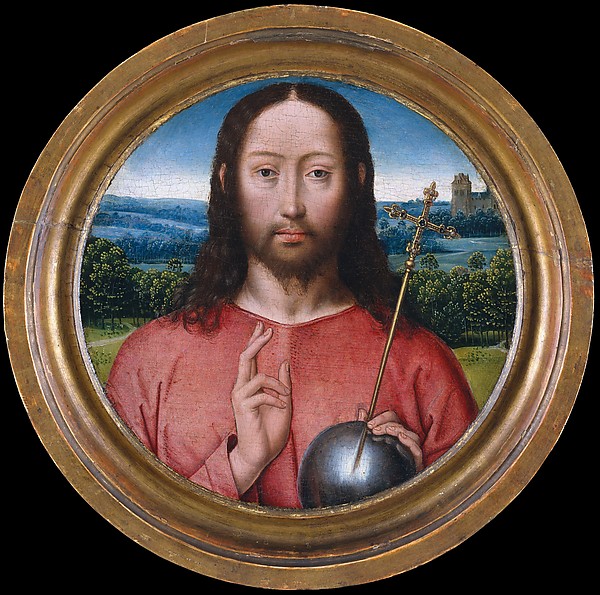
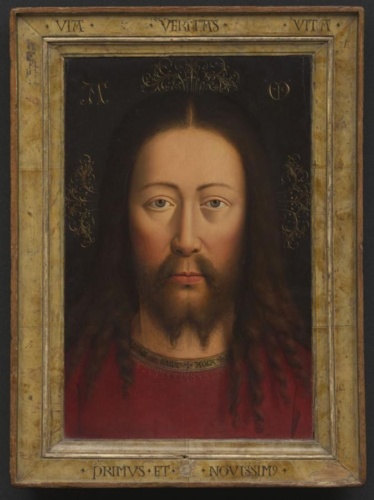
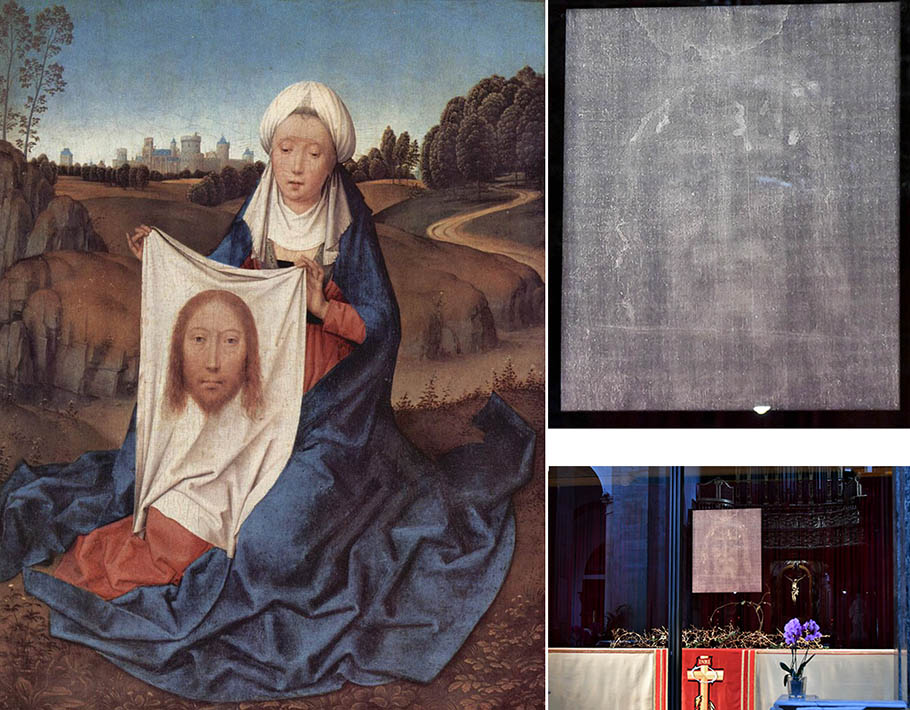
What looks like Leonardo…
In classical art, the artist sketches the subject, transfers the lines and paints them in warm, brown paint on panel or canvas. He then layers color in subsequent layers. In the old masters technique, multiple layers were very thin to achieve the desired atmospheric effect. The da Vinci's sfumato technique involves multiple glazing of thin paint, so thin that some areas don't even show up in the X-ray examinations. In his podcast interview Robert Simon describes how they took a probe on the face of the Salvator Mundi to reveal 17 layers of paint!
His Face
By looking at some copy paintings above it’s easy to see that these artists were able to copy the beautiful hand, orb and delicate pattern of the clothing. However, none of them could copy the same glowing face of the da Vinci painting. The ambiguous face in the Salvator Mundi is so much like Leonardo. Illusive. Ethereal. Glowing. The artist achieved such appearance in his art by glazing very thin layers of oil paint. By mixing the paint with a lot of medium (linseed oil or other oil) the artist created the sfumato technique, the very style we see in the Mona Lisa, the Saint John the Baptist, and in the Virgin and Child with St. Anne. And by looking at the painting for the first time without studying it carefully, it’s easy to conclude that it’s by Leonardo because the painting art style is so similar to other works created by the artist.
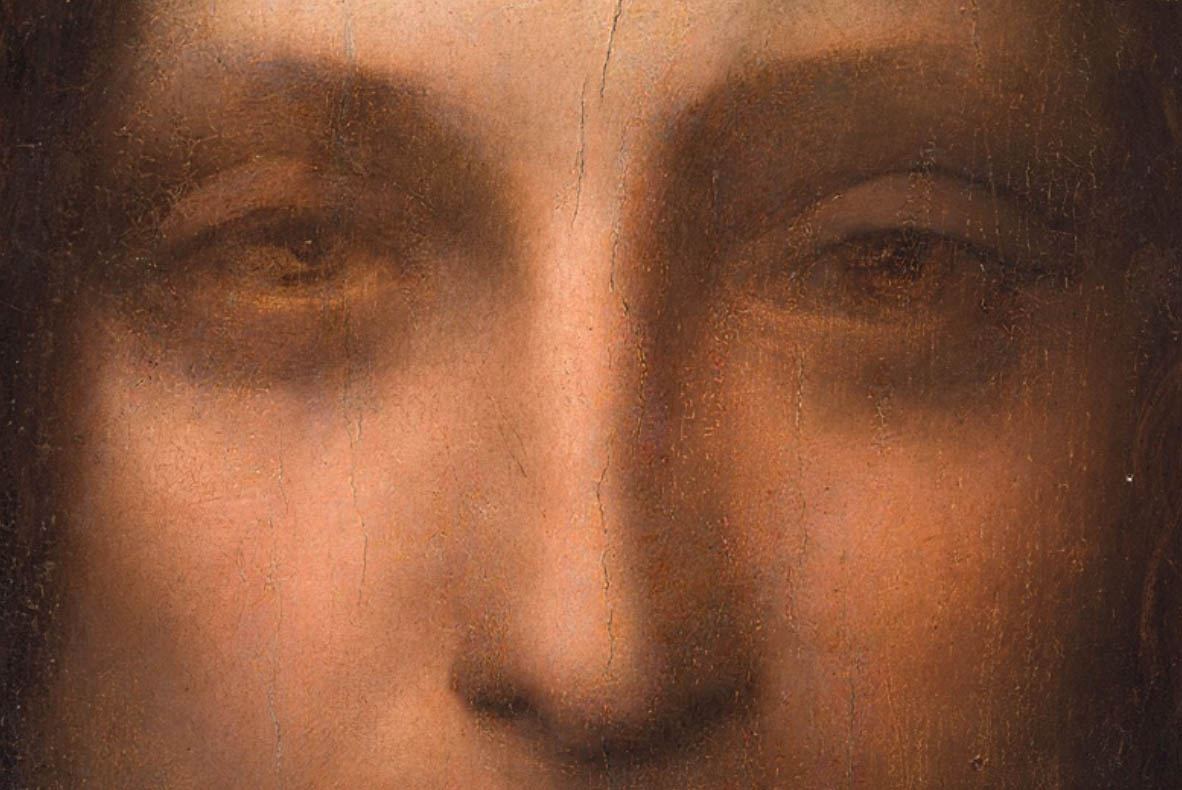
If you look at the restored portrait closely, you’ll notice the discrepancies that Leonardo couldn’t have done himself. While the painting style is so Leonardonesque, the crooked tip of the nose and the cross-eyed appearance of Christ raise questions for me as an artist. Being a scientist, Leonardo’s anatomy drawings show exquisite understanding and perfection of human form of that period, so these anatomical discrepancies look like obvious flaws. Why would the artist paint the body of Christ with such symmetry and ignore the symmetry of the eyes and nose? One explanation is that the panel has cracked and warped so much in five centuries that it changed the appearance of the drawing in the nose and chipped off some paint in the eyes (which is hard to believe because the pupils look so uneven, and the shape of the eyes is different). I would like to hear the restorer’s explanation to understand this. If you look at this picture where I overlay straight lines over his face, you can see how crooked the nose is, which lines up with the mouth but not with the top part of the face. The eyes don’t line up either, each having a different shape. In other Leonardo’s drawings and paintings you can see a more complicated rotations of the head that demand a perfect line up of facial features.
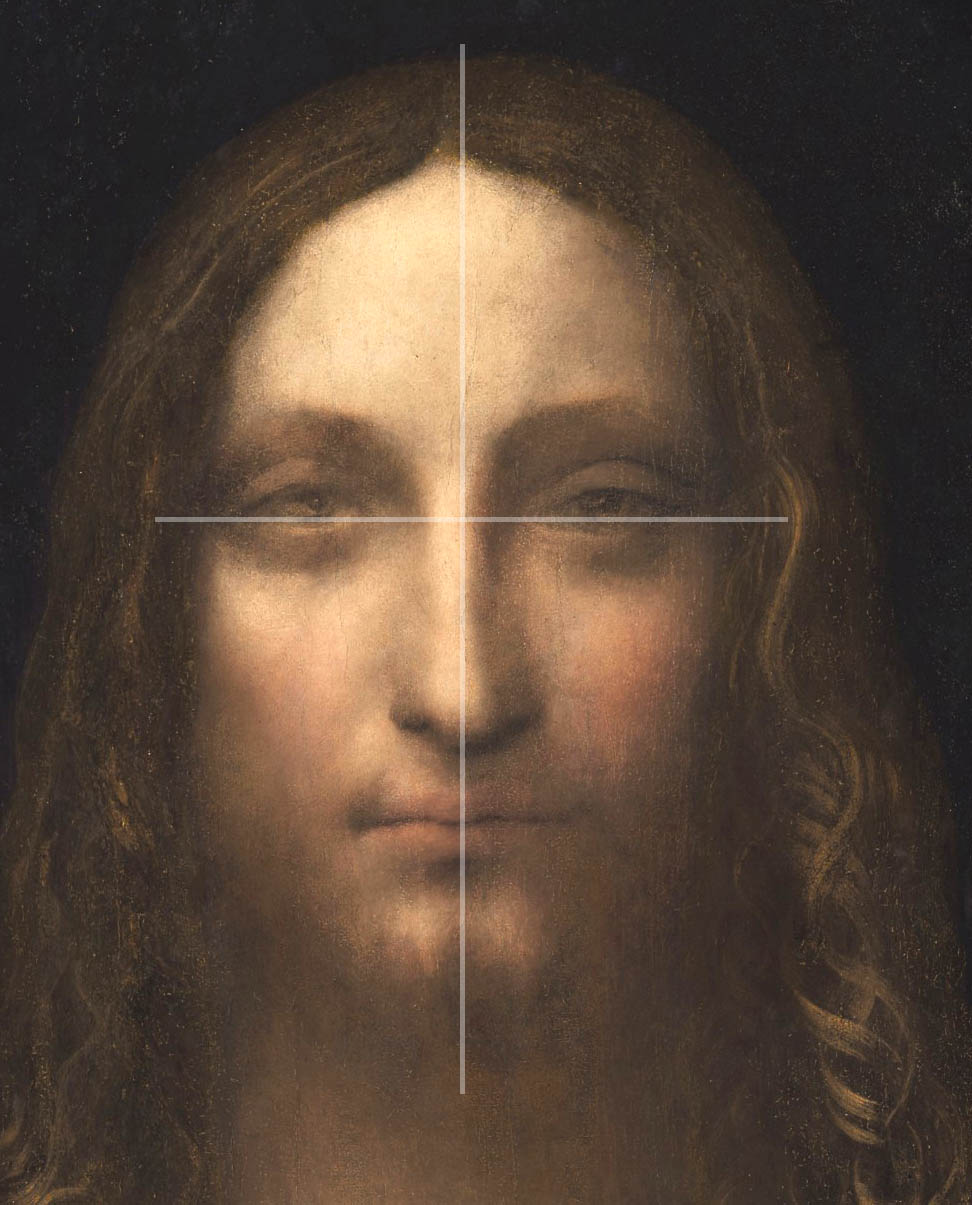
Moreover, In the Hollar’s etching we can see that the Christ’s eyes look in a different direction compared to the painting’s straight gaze. The man also wears a definite beard in the etching unlike in the da Vinci’s painting that looks soft and illusive.
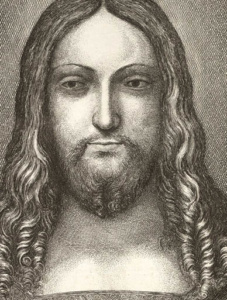
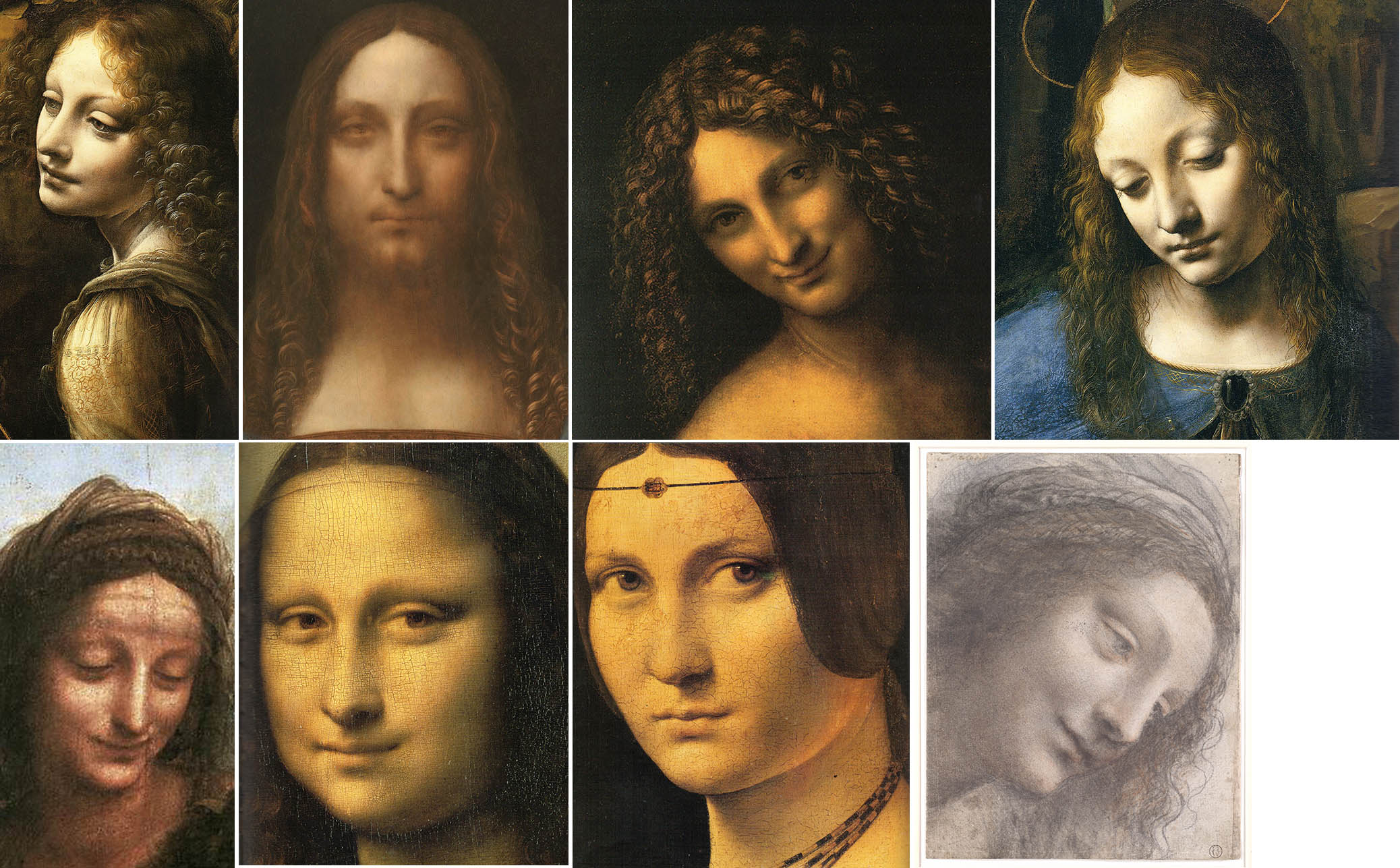
Moreover, the presented Salvator Mundi has a non-existent neck. When you look at the line up of faces from da Vinci paintings above, you see a different style of painting the neck. All of them are cylinder-like with considerable definition and naturalistic detail. In the Salvator Mundi painting the neck is obscure and ill-defined unlike in other da Vinci paintings. Also, all known paintings by da Vinci have the models rotating in space a lot. The Salvator Mundi portrait is so frontal it’s inconsistent with the artist’s work.
His Hand
The Salvator Mundi blessing hand is the most realistic, da Vinci-like element in the entire painting. Its elegant design and unbelievably well-painted anatomy make it the best hand by Leonardo I’ve seen in comparison to his other paintings. It’s the most believable element in the painting that looks like Leonardo painted it.
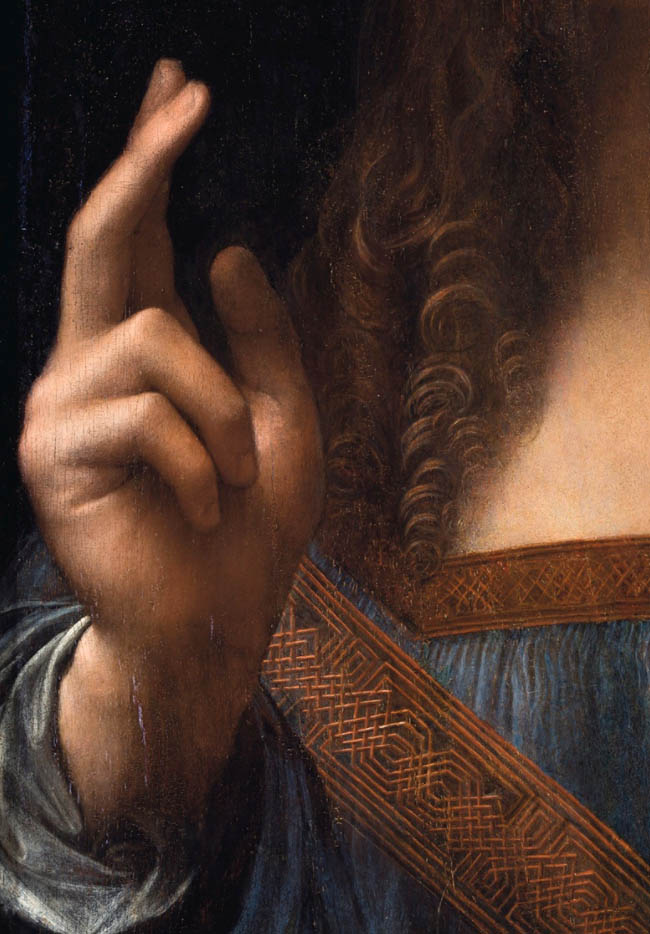
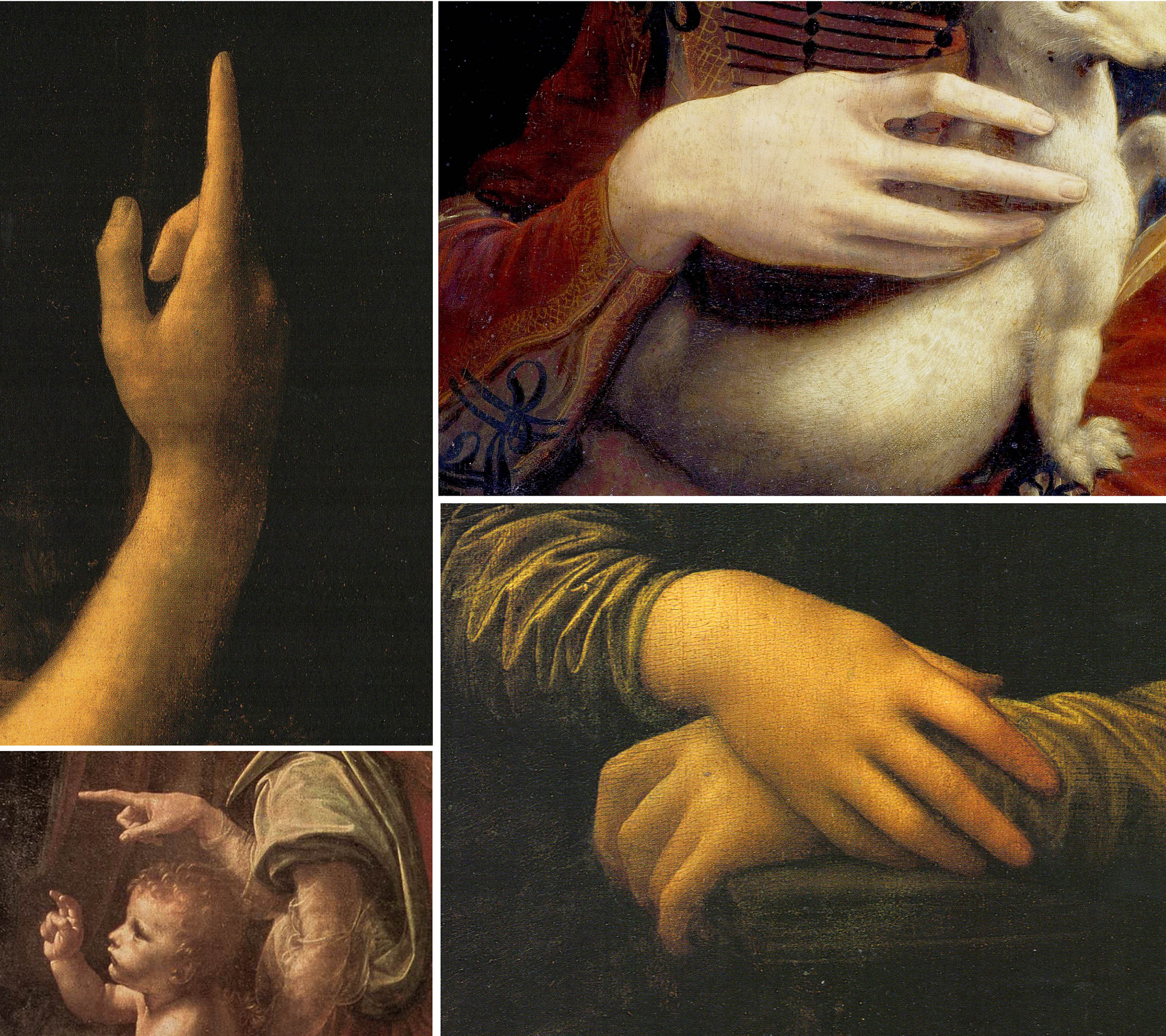
His Hair

While we can see the Leonardonesque hair in this portrait where every strand is observed, this visual element is actually prone to copying by other artists (see the image above of Salvator Mundi, School of Leonardo da Vinci, c.1503 ). The Leonardonesque hair type was a very popular element in the Italian Renaissance painting. Therefore, its hard to say that Leonardo was the only artist painting these beautiful curls in this manner. Leonardo got his initial training in the Andrea del Verrocchio’s workshop in Florence where he assisted the master artist in completion of art, working among many other students. Here we can see this manner of painting the curls.
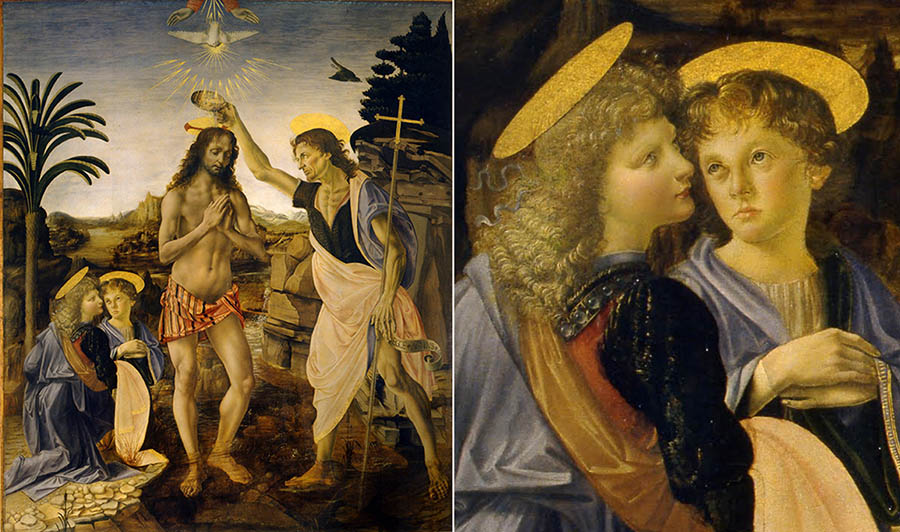
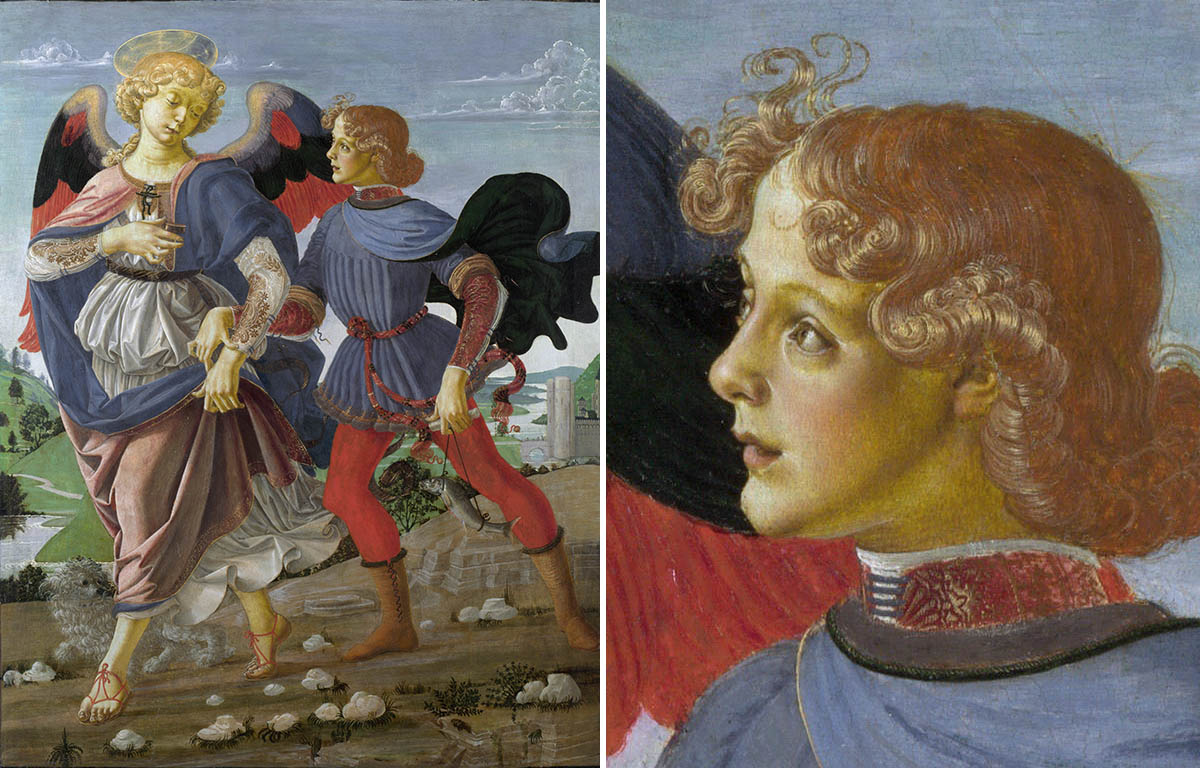

The painting’s restoration process
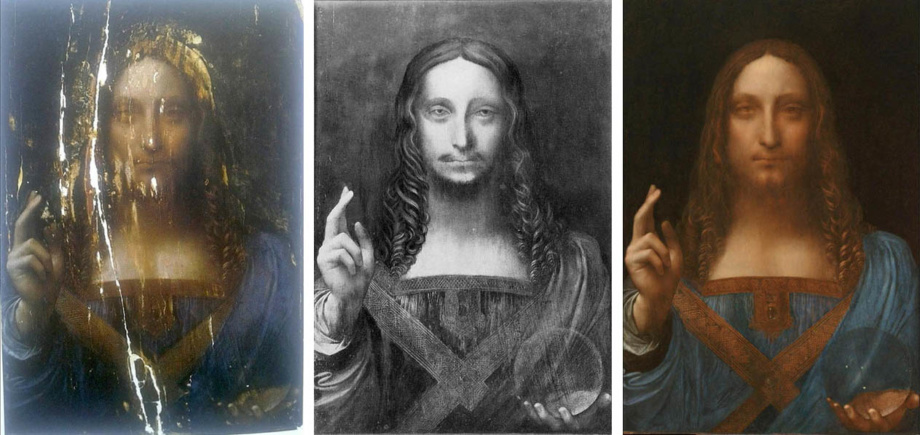
In general, paintings get cleaned by removing the varnish, which is a protective coating that traps the dirt and UV light, and protects the oil paint from damage. Usually the removal of old varnish, reveals a much lighter and brighter painting with the original, beautiful colors painted by the artist. High-quality paints wouldn’t fade as much, rather would become more transparent with age. What we see in the first image is the removal of the overpainted image that reveals the original painting underneath it. White lines look like gesso marks crudely painted over the cracks of the original painting trying to fill them in. Oil paint is applied over the gesso to create a painting. By comparing the first and the last image we can see how much restoration was done.
In the interview Mr. Simon says that the Salvator Mundi came to him in terrible condition: the walnut panel had a big vertical crack that was poorly repaired and repainted multiple times over. Smaller cracks and hastily repairs damaged the surface to a great degree.
Dianne Modestini made an incredible job cleaning and restoring the artwork. She didn’t just create a new version of Christ like we see in the overpainted image in the center. Rather, she stripped the painting down to its original state, fixing the “scratches.” The Da Vinci’s signature style – sfumato and the ethereal appearance of the face, are present after 500 years from its creation. The original color of clothing may have been different, however, probably having brighter blues in the beginning. Here is what the restorer says about the painting on Christie’s website.
Dianne Modestini explains that the original walnut panel on which Leonardo, who was known for his use of experimental material, executed Salvator Mundi contained a knot which had split early in its history. However, she concludes that important parts of the painting are remarkably well-preserved, and close to their original state. These include both of Christ’s hands, the exquisitely rendered curls of his hair, the orb, and much of his drapery. The magnificently executed blessing hand, Modestini notes, is intact. With regards to the face, Modestini comments, ‘Fortunately, apart from the discrete losses, the flesh tones of the face retain their entire layer structure, including the final scumbles and glazes. These passages have not suffered from abrasion; if they had I wouldn’t have been able to reconstruct the losses.
During the conservation process, pentimenti — preliminary compositional ideas, subsequently changed by the artist in the finished painting, but not reflected in the etching or painted copies — are observed through infrared imaging, and duly photographed. The most prominent is a first position for the thumb in the blessing hand, more upright than in the finished picture. IRR imagery also reveals distinct handprints, especially evident on the proper left side of Christ’s forehead, where the artist smoothed and blotted the paint with his palm. This kneading of the paint in order to create soft and amorphous effects of shadow and light is typical of the artist’s technique in the latter part of Leonardo’s career. reference: http://www.christies.com/features/Salvator-Mundi-timeline-8644-3.aspx )
da Vinci’s materials and the preparatory ground
Because the artwork’s creation is placed close to the Mona Lisa painting in its style and dates, one of the clues to the authentication of the Salvator Mundi would be the examination and analysis under a microscope of preparatory ground (gesso) underneath the oil paint. It’s known that Leonardo tinted the ground in two colors: blue under the top/ landscape area; red under the bottom area in Mona Lisa, La Belle Ferronniere, The Musician, and St. Anne. ( Pietro C. Marani, Leonardo da Vinci, the complete paintings, Harry N. Abrams, inc. publishers, p. 198). Such examination would also reveal marks of an underlying drawing traced in the ground. Christie’s website mentions spolveri — pouncing — can be seen running along the line of the upper lip. “The rest of the body has a much looser, brushy underdrawing, with further small changes of mind. This combination of careful preparation for the head and much greater improvisation for the body is characteristic of Leonardo.” The X-rays would show different positions or variations of features from the finished painting. Because da Vinci painted in very thin glazes, some elements like an illusive smile or hair may not show up in the X-rayed images.
On the Christie’s website you’ll find this statement. “Powerfully convincing evidence of Leonardo’s authorship was provided by the discovery of numerous pentimenti — preliminary composition ideas, subsequently changed by the artist in the finished painting, but not reflected in the etching or painted copies. The most prominent of these — a first position for the thumb in the blessing hand, more upright than in the finished picture — was uncovered and photographed during the conservation process.” Further examination with infrared imaging would show additional pentimenti- changes in the drawing, which are recorded on the Christie’s website as subtle changes found in the contour of the hand holding the orb.
While these discoveries of pentimenti and spolveri are good indications of the old master work, they are not exclusive to Leonardo’s method of work. And if we think of a careful forgery, this method of working on a painting could have been forged after reading a comprehensive book on Leonardo.
Da Vinci was famous for his experimentation with materials and techniques (Look at the terrible condition of the Last Supper mural). While most artists of his time painted on poplar panels, he chose the walnut one. (Half of his paintings are on poplar wood). He also was one of the first painters to use the walnut oil, which slows down the drying time of oil paint and thus allows for a prolonged painting period. While the walnut oil doesn’t yellow unlike the linseed oil, it’s less stable and may contribute to a weaker bond between many layers of paint and thus makes the painting more susceptible to damage in the long run.
Technical examinations and analyses have demonstrated the consistency of the pigments, media, and technique discovered in Salvator Mundi with those known to have been used by Leonardo. Syson notes particularly the use of precious lapis lazuli in the Christ’s celestial blue clothes, a practice that was unusual at this date, suggestive of the opulence of the commission.
Da Vinci was not the only artist to use precious pigments in his art. Florentine artist Giotto (c. 1266-1337) comes to mind. Therefore it can’t be a strong argument to authenticate the painting based on the precious pigments used, in my opinion.
What’s fake? (or added after Leonardo)
The da Vinci’s orb may not be by da Vinci
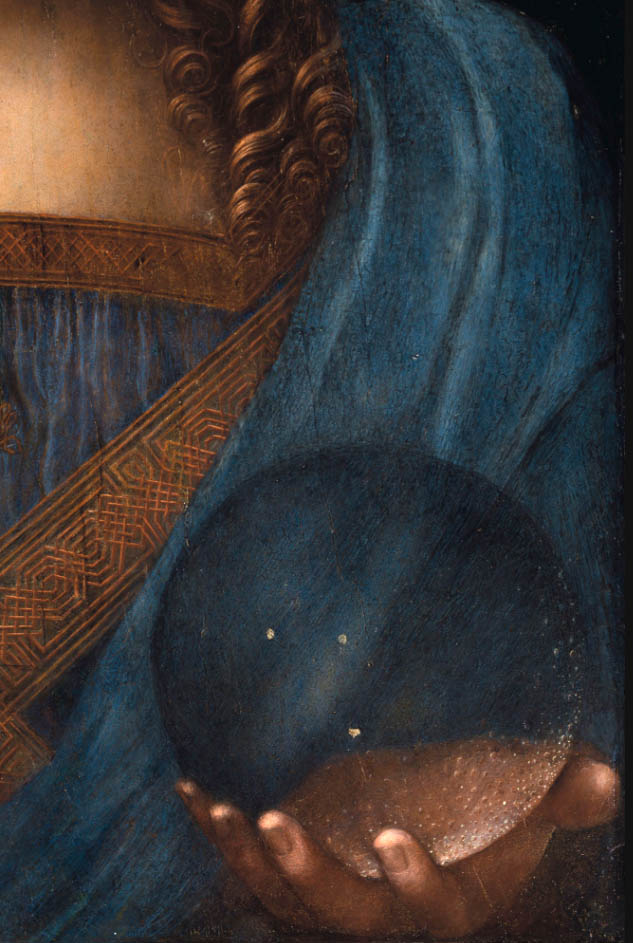
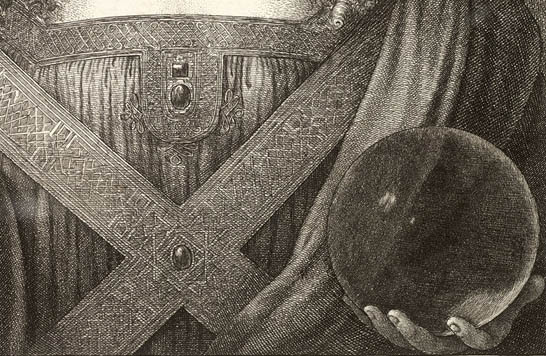
The orb’s reflection makes this painting the hardest thing to believe that it’s by da Vinci. It’s painted with transparency of glass that’s impossible to achieve, considering the shape and properties of the orb, regardless its material. da Vinci was a scientist who studied the effects of optics and light extensively. His knowledge of optics is shown in his atmospheric quality of layering paint on figures and landscape backgrounds. There are many scientific drawings made by Leonardo that show his curiosity and understanding of nature. As an artist he was exceptional at perfecting every aspect of painting: composition, atmosphere, color, anatomy, etc. In the following pictures you can see how the orb’s reflection looks like. I’m tempted to speculate that the Da Vinci’s original was unfinished at the time he needed to give it to the king Louis XII, and it was hastily completed by one of his students. Leonardo was notorious for not finishing his projects (and not just paintings), and like in the Mona Lisa case, it’s presumed the painting traveled with the artist, and he worked on it on and off for about 5 years. Or perhaps, the referenced orb was made of a different material rather than the one shown below.
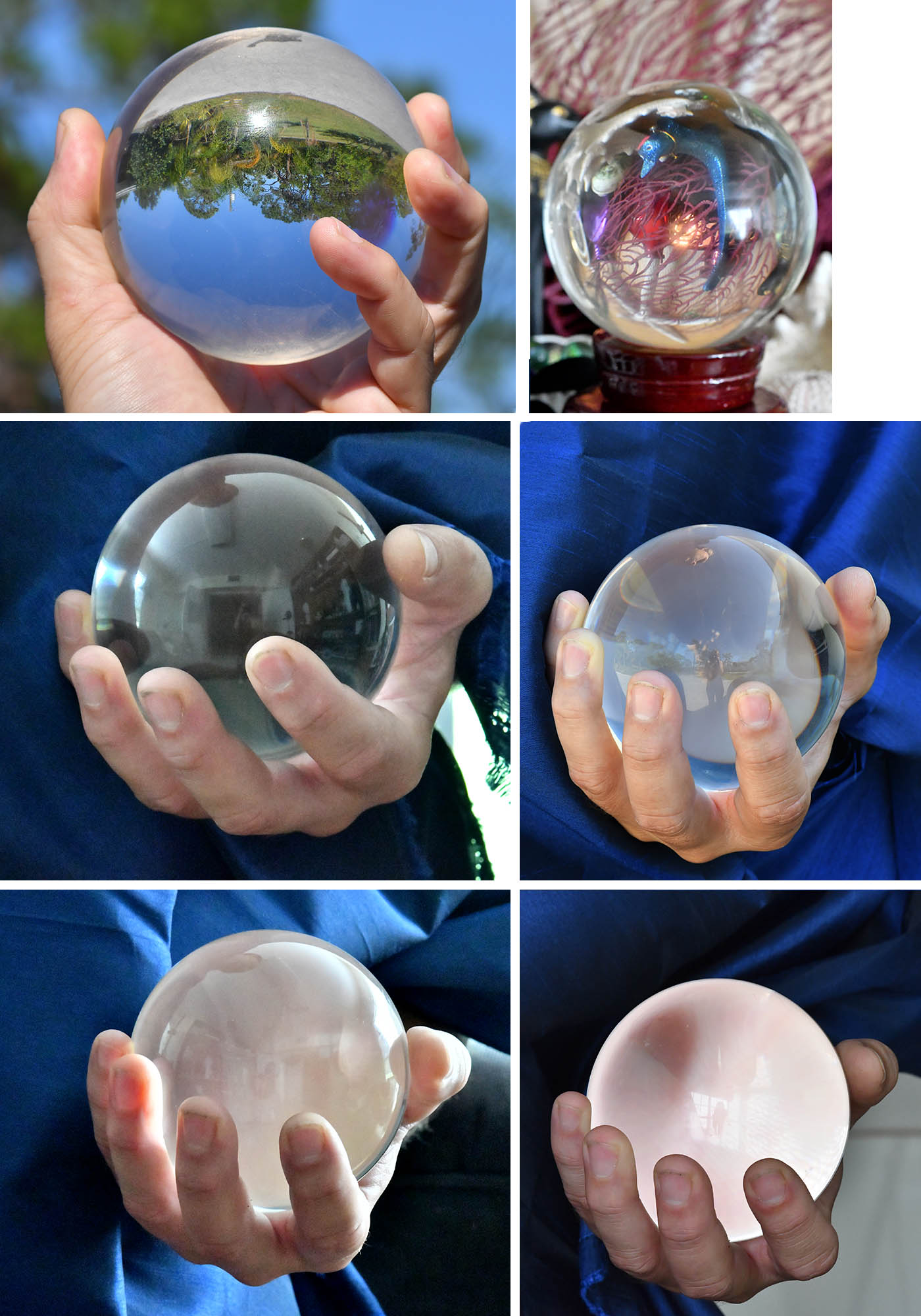
Isaacson believes that this was “a conscious decision on Leonardo’s part”,[33] and speculates that either Leonardo felt a more accurate portrayal would be distracting, or “he was subtly trying to impart a miraculous quality to Christ and his orb”.[32] Kemp, on the other hand, says the doubled outline of the heel of the hand holding the sphere—which the restorer described as a pentimento—is an accurate rendering of the refraction produced by a calcite sphere.[27]
Both of these statements are questionable. At the same time, it seems close to impossible that Leonardo would override his scientific side in favor of a creative interpretation. ( da Vinci considered himself a scientist, not a painter by writing a letter to L. Sforza of Milan offering his services to the court as a military engineer, not an artist.)
Composition and background
Many are concerned with the provenance of the da Vinci painting due to its tight, unlike-da-Vinci composition and a dark, empty background. While the background itself is of a lesser concern here because da Vinci painted several artworks with similar, dark background, what’s unclear why the figure is so frontal and sits so close to the edge.
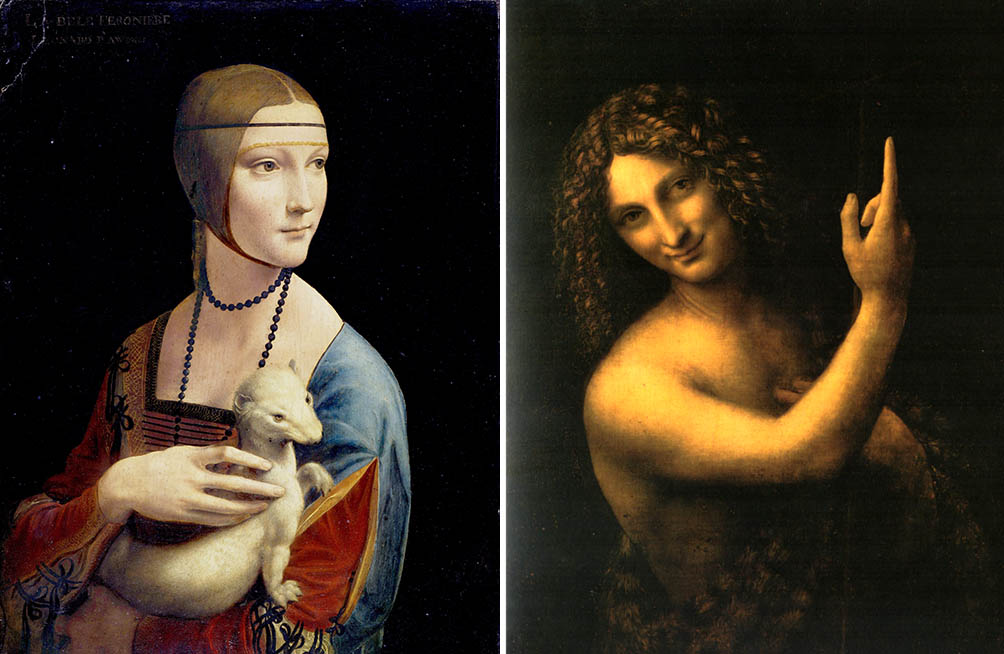
No realist artist would allow himself to place a figure so tight to the edge of the frame like we see in the Salvator Mundi. While this is a common mistake for a beginner artist, artists like da Vinci just couldn’t afford sacrificing composition to this degree. When the form is so close to the edge, it creates tension, which every good artist tries to avoid making. If the sleeve or hand gets cropped, it should look intentional and more definite (like we see in the Impressionists). In this painting we observe Christ’s hands and arms sitting so unbelievably close to the edge of the painting, the figure barely fits in the frame. The only explanation of such positioning is cropping of a wood panel at a later stage in history of this painting. Note that we can see the same tight cropping of the figure in the Hollar’s etching and other copy paintings! How would this be possible? Was the original painting cropped within the first 100 years of storage in a convent? What would be the reason for doing so? No adequate frame was found around to fit it in? Was the etching done not from the original da Vinci, which makes this painting forged from the etching itself?
In his art Leonardo rotated the figures to get a more dynamic and dramatic position of a model. He either twisted the figures or used three-quarters view in portraiture art. Was it his intention to reverse to the iconic imagery of the Medieval art to create a more universal image of Christ? There is a long history of iconography with frontal depiction of Christ that makes me think if Leonardo could make himself skip on his innovations in composition, reverting to this Medieval, symmetrical, iconic image of Christ.
Some argue that it’s work by Leonardo because of the triangular composition (hands and head form a triangle). However, triangles were widely used by many artists as a design element in painting. We can also argue that the Salvator Mundi is either a forgery or an inspiration for other artists by comparing its composition to the Durer’s self-portrait at 28. What’s interesting here is that although Durer was German, he traveled to Italy around that time and may have seen the da Vinci’s work-in-progress in person, because this self-portrait is drastically different from his previous two. Or we can argue that the forger tried to create this universal, frontal image of Christ basing it off of the etching and Durer’s portrait.
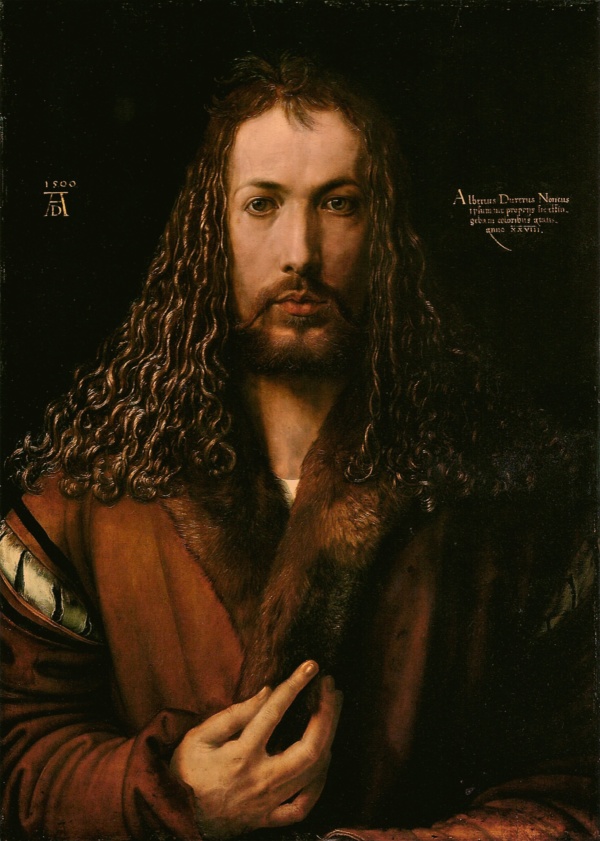
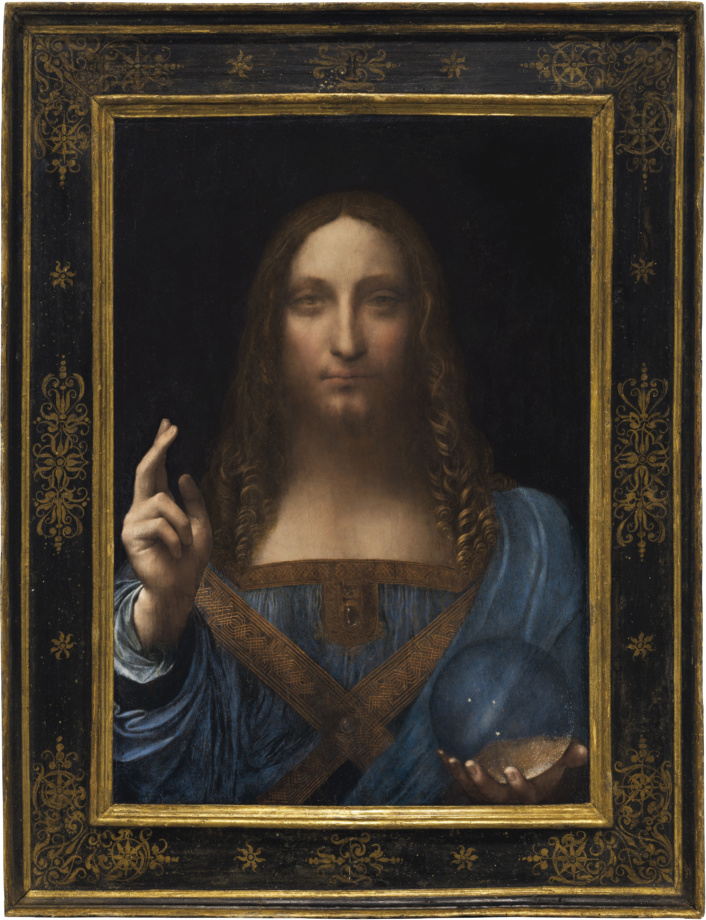
Conclusion
The controversy surrounding Salvator Mundi is likely to continue for many years to come. Until the painting is publicly exhibited and subjected to further scientific analysis, it is impossible to say definitively whether it is a genuine work by Leonardo da Vinci. The lack of public exhibition has only fueled the debate over the painting’s authenticity. Some experts believe that the Louvre Abu Dhabi is hesitant to display the painting because they are unsure of its authenticity. Others believe that the museum is simply trying to protect the painting from damage.
The more I study the Salvator Mundi, the more questions it raises. And the deeper I go, the more puzzling the inconsistencies in its origin become. Despite my first impression that the portrait has the da Vinci’s signature appearance with every detail and magical golden glow, all the problems I’ve listed above make me think that it’s either Leonardo’s underpainting finished by his student (considered the Old Master’s work), or it’s a complete forgery. What’s clear is that it’s not enough to compare the da Vinci’s paintings visually. Only a thorough examination of all written documents as well as modern chemical analysis of the painting (and the etching) could authenticate the present Salvator Mundi by giving us the original dates. No matter how much time the experts would spend comparing this work to others done by da Vinci, there is still a lot of doubt in place if it’s his. And if it’s not a skillful forgery, Leonardo’s style is most definite in the face and the blessing hand, not in the orb, hair or fabric, which are fairly easy to forge by a contemporary realist artist or a restorer.
Of course, this painting and its origin may deserve the criticism it receives from people working in the field that includes many experts on da Vinci’s art. Perhaps it may receive some criticism from art critics like we see here by Jerry Saltz. However, if someone is not an artist, hasn’t held a brush long enough to understand how hard realist painting is, or has meager knowledge of art history should refrain from posting negative comments about the restorer on social media, which I’ve seen a lot. We can still enjoy the art and discover new secrets about Leonardo and his circle.
Check out visionary art for sale
Resources:
Scholarly papers database http://www.jstor.org | Snow-Smith, J. (1978). The Salvator Mundi of Leonardo da Vinci. Arte Lombarda, (50), nuova serie, 69-81. Retrieved from http://www.jstor.org/stable/43105161
Pietro C. Marani, Leonardo da Vinci, the complete paintings, Harry N. Abrams, inc. publishers
Windsor Castle royal collection: https://www.royalcollection.org.uk/collection/search#/page/1
Christie’s timeline: http://www.christies.com/features/Salvator-Mundi-timeline-8644-3.aspx
Christie’s http://www.christies.com/features/The-last-da-Vinci-Salvator-Mundi-8598-3.aspx
Suggested Donation: http://www.suggesteddonationpodcast.com/blog/2015/9/15/episode-21-robert-simon
Old Master Dealer Robert Simon https://www.robertsimon.com/leonardos-salvator-mundi/
*I wrote this article on Nov.24, 2017 and updated it slightly in 2023 to include the most recent information on it.
